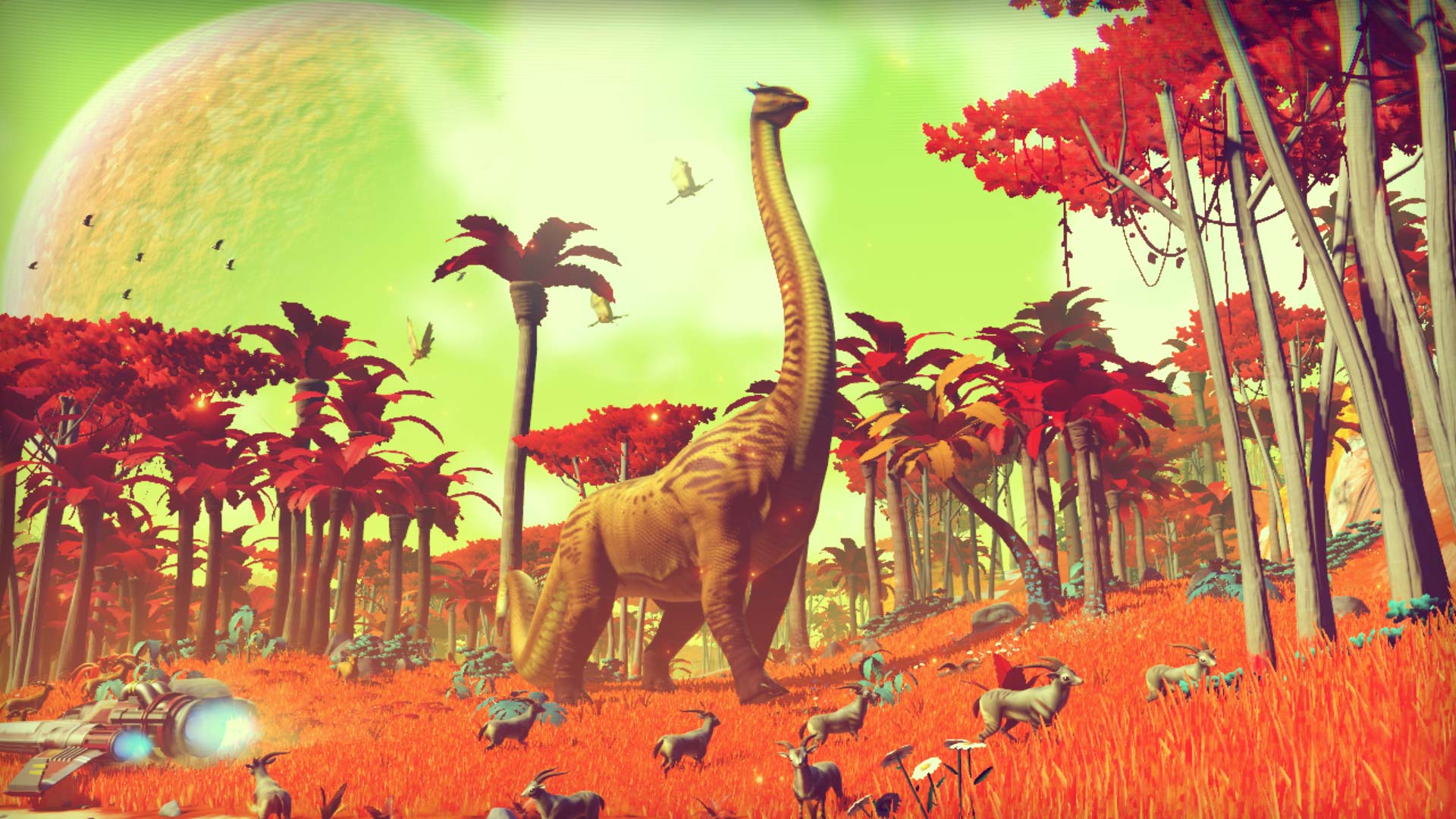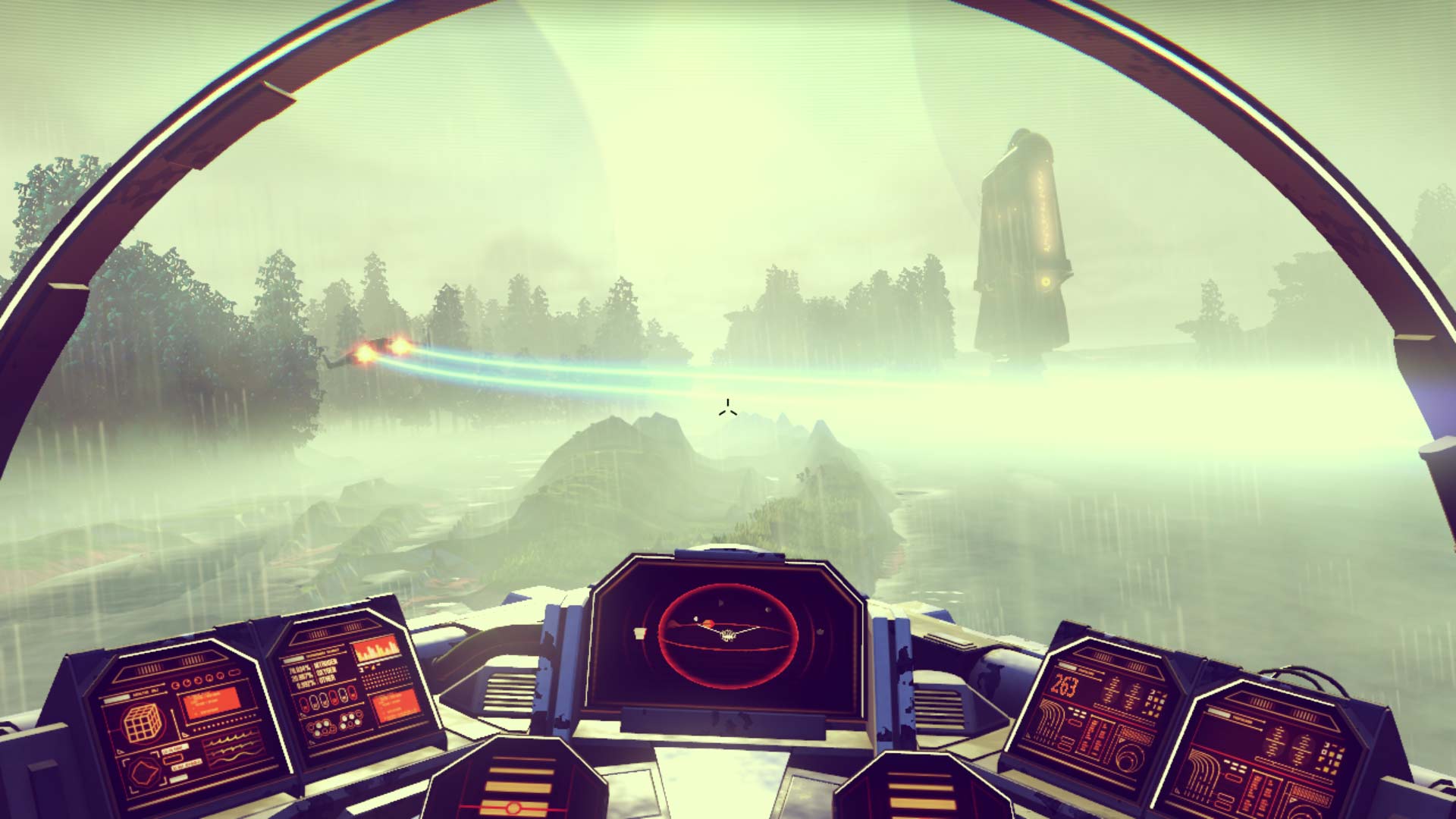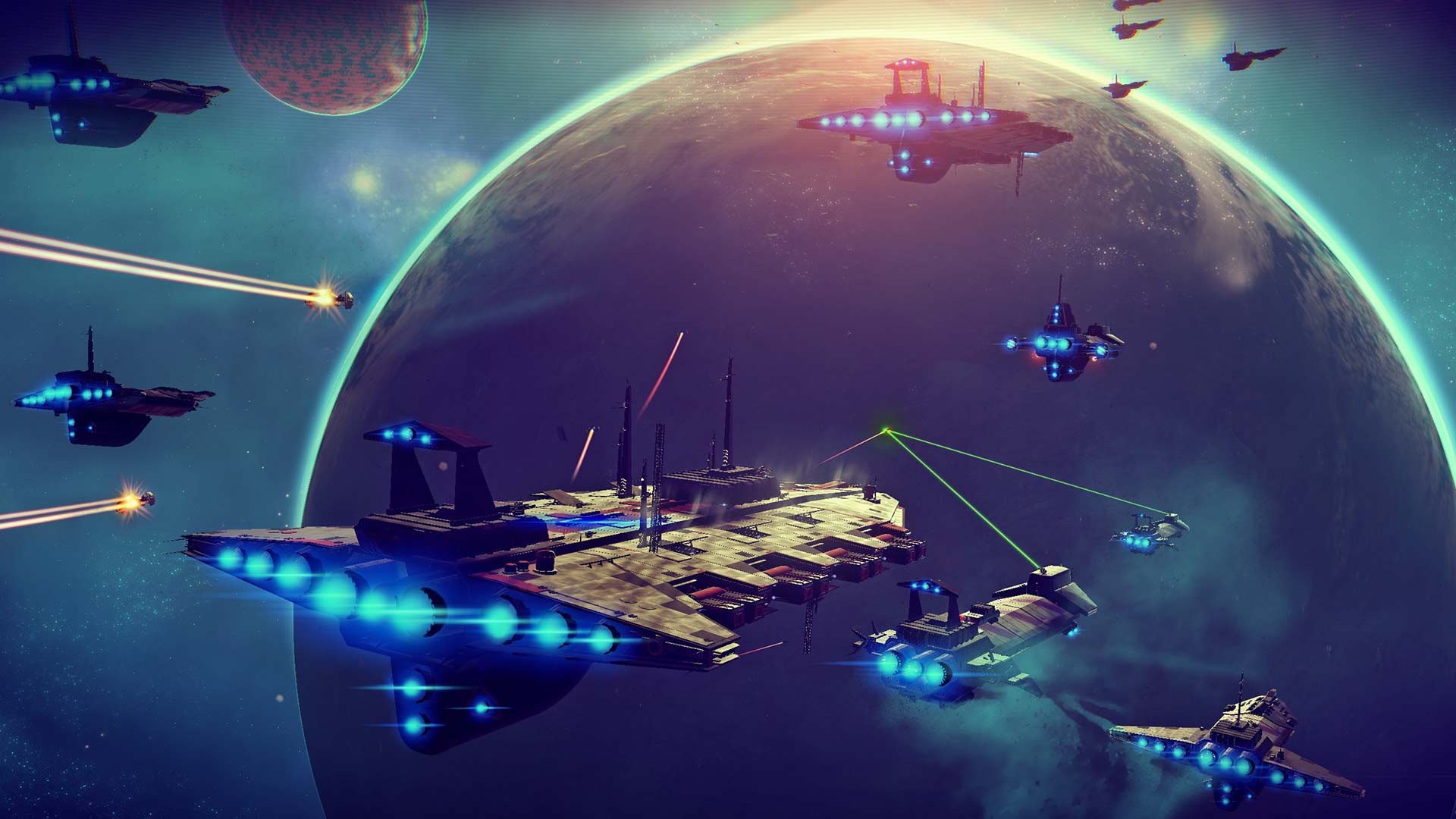Tom's Guide Verdict
No Man's Sky is a gorgeous game that gives players a satisfying sense of exploration, but the experience can be incredibly repetitive.
Pros
- +
Beautiful visuals
- +
Satisfying end-goals
- +
Exploration yields real moments of joy
Cons
- -
Repetitive survival elements
- -
Tedious ship maintenance
- -
Variety is mostly skin-deep
Why you can trust Tom's Guide
"Space is big. Really big. You just won't believe how vastly, hugely, mind-bogglingly big it is. I mean, you may think it's a long way down the road to the chemist's, but that's just peanuts to space." — Douglas Adams, "The Hitchhiker's Guide to the Galaxy"
With all due deference to Douglas Adams, space isn't just big — it's also mostly empty. Aside from a few planets, asteroids and comets located one place or another, there's just not a whole lot going on among the approximately 100 billion stars in Earth's galaxy. Most planets probably don't harbor life; most life probably isn't intelligent; most intelligent life is probably incomprehensible to humans. If No Man's Sky intended to get this point across, it has succeeded.
If, on the other hand, No Man's Sky aimed to be an endlessly enjoyable game that defined new boundaries in the space-simulation genre, it's had mixed results. The setup is simple enough: Take control of a starship and explore quintillions of planets across an impossibly vast galaxy, claiming discoveries of new planets and life forms as you go. The problem is that the concept — which Hello Games delivered as faithfully as possible — incorporates as much tedium as fun.

No Man's Sky isn't the rollicking space adventure that the early demos appeared to promise, nor is it a mindless trudge through an uncaring universe. In actuality, it's a bit of both, and will probably alienate as many gamers as it delights.
Gameplay: A galactic grind
When No Man's Sky begins, you find yourself on a deserted planet with a busted spaceship and only a simple mining laser in your hand. There are some rather vague instructions about patching up your ship, but other than that, you're on your own. As you progress through the game, you'll find that this hands-off approach is the modus operandi.
The game never tells you, for example, that you can feed resources into your suit to replenish its life-support and environmental controls. Nor does the game mention that you're probably going to want to build a scanner, which means you need carbon. And for that, you need to bust up some plants, which the game also fails to explain.

A lot of No Man's Sky is like this. There's a certain internal logic and rhythm to the game, but you have to suss it out on your own. Figuring out each detail doesn't feel rewarding, though; instead, it feels like completing another item on a checklist, and that checklist gets longer the more you play.
Get instant access to breaking news, the hottest reviews, great deals and helpful tips.
Gather elements to recharge your suit. Gather elements to recharge your life support. Gather elements to power your ship's liftoff. Gather elements to power your ship's booster drive. Gather elements to power your ship's sublight drive. And when you finally get a hyperdrive a few hours in? Forget it. The process for creating warp cores to power interstellar travel is yet another needlessly tedious process that you have to do constantly in order to make any progress.
You can see some truly spectacular things, but only if you can bear with the game's unceasing grind.
Bear in mind that you don't just have to undergo these steps once to get things rolling; you have to recharge everything, all the time, which means you'll also need to collect everything, all the time. And your inventory space is severely limited, unless you power up your weapon/suit/ship, which means you'll have to explore for upgrades, which means you'll have to chart new planets, which means you'll have to expend more resources …
You get the idea.
What you end up with is not a spaceship for exploring the vastness of the cosmos, but a treadmill. You can see some truly spectacular things, but only if you can bear with the unceasing grind. You can alleviate the tedium with upgrade blueprints (which are totally randomized, so good luck finding the ones you need), but it never completely goes away. The grind is arguably the game's central mechanic.
Exploration
If (not when — if) you can get past all that, however, there's a somewhat meaty game waiting underneath. There's a lot that you can do in No Man's Sky, and most of it works pretty well. You can chart new star systems and new worlds, engage in space battles with hostile forces, catalogue new forms of planetary life, trade fire with sentry drones, salvage downed ships, explore ancient ruins, break into guarded facilities for new blueprints, hang out at intergalactic trading posts, and more.
MORE: Best PS4 Games of 2016
My personal favorite activity was meeting alien nonplayer characters and slowly, but surely gathering more words in their esoteric tongues. From an initial state of complete confusion, I began to slowly understand what my alien colleagues were trying to tell me. It's not a bad metaphor for No Man's Sky itself.

"Functional" best describes the myriad forms of gameplay. Space combat works, but it's not up to the level of something you'd see in an honest-to-goodness dogfighting game. (Stopping to recharge shields is especially dull.) Exploring planets by ship, foot and jetpack is simple enough, but the planets are enormous, and interesting waypoints are few and far between. The new life-forms you encounter are sometimes odd enough to warrant a second look (one creature I saw resembled a cross between a Labrador retriever and a triceratops), but they're mostly just variations on real-world mammals and dinosaurs.
The planets and star systems, which can seem wildly different at first, will also start to boil down to the same basic elements.
One area where the game mostly succeeds, though, is in its ambient, minimalist storytelling. Early on in the game, you'll learn that there are two (possibly three, depending on how you play) potential paths to explore No Man's Sky. Without spoiling anything, one path puts you on the quickest possible route to the center of the galaxy, and the other involves ancient alien artifacts and a more mysterious endgame. Once I found these options, I immediately felt more at home. I was no longer just exploring procedurally generated planets for their own sake; I was doing it in service of a bigger goal.
There is indeed some cool lore, no matter which path you take, and having a goal in mind, however vague or distant, helps make No Man's Sky feel like an adventure rather than an aimless jaunt. On the other hand, having a goal also exacerbates how repetitive the game can become. Explore strange, new world after strange, new world to scrounge up enough material for a few hyperspace jumps. Arrive at your plot-designated waypoint, which gives you a vague bit of story, and another waypoint to reach. Lather, rinse, repeat.

The planets and star systems, which can seem wildly different at first, will also start to boil down to the same basic elements. Maybe the planet is radioactive, or very cold, or very hot, but you're going to have to recharge your suit just the same. You'll find some weird-looking aliens, but you can do that on any planet. Maybe you'll learn a new alien word or find a trading post or come across a derelict ship, but this stuff could happen anywhere. Even the thrill of seeing your name next to a planet you've discovered dims somewhat once you realize that a) everyone has done the same thing and b) few people are likely to ever come across your system again.
Graphics and Sound
At least the game is easy on the eyes. With a full, saturated palette, No Man's Sky prefers the vibrant blues, greens and oranges of gassy nebulae to the stark blacks and whites of a starry night. (Although it would be nice to find that pure black on occasion.) Planets are agreeably garish, and the whole game has a kind of pastel filter that makes it just weird enough to accept at face value.
The sound is, likewise, fine, with ambient electronic music for exploring, and alien grunts and groans rather than spoken dialogue. It's all in keeping with the abstract, experimental nature of the game.
Bottom Line
Imagine this: You sit down to watch an episode of Star Trek. The Enterprise glides along through the starry sky, and Capt. Picard narrates that the crew will soon survey a nearby planet that's not known to harbor any sapient life-forms. The away team beams down … then it maps the planet, catalogues its findings, packs up and moves onto the next assignment. There's no diplomatic incident, no moral quandary, no spatial anomaly, no unexpected visitors and no character drama. That's what No Man's Sky feels like.
MORE: Beyond Pokemon Go: 10 Games We Want to See in AR
Then again, it's not totally fair to characterize No Man's Sky as a failed space opera; it's not. It's a game about exploration first and foremost, and when you get into a groove, it's easy to see the title's appeal. Sometimes, you'll juice up your hyperdrive, jump to an unexplored system, find some amazing technology and unexpected critters, and gain a few snippets about your mysterious end goal. But then you'll have to repair your ship, find a better exosuit, barter with incomprehensible aliens and check planet after planet for that one resource you need, and the whole cycle starts all over again.
If you fall for No Man's Sky, I predict you'll fall hard, as many gamers already have. But, whatever kind of hype it generated over the past few years of pre-release development, the game is a surprisingly niche title, and has as much to do with crafting and survival as it does with exploration. It's gonna be a long, long time before you reach your destination, and it's lonely out in space.

Marshall Honorof was a senior editor for Tom's Guide, overseeing the site's coverage of gaming hardware and software. He comes from a science writing background, having studied paleomammalogy, biological anthropology, and the history of science and technology. After hours, you can find him practicing taekwondo or doing deep dives on classic sci-fi.
-
Daekar3 I agree with Marshall, you're going to either love it or hate it. To me, it's a relaxing hail back to some of the older space games, and I was really surprised how much I enjoyed the exploration. In fact, it's kind of shocking when the local fauna prove to be aggressive. I've spent over 10 hours in game, and haven't left my home system, although I've gotten quite a few upgrades and scanned / named all the species in two planets and almost all on the third.Reply
I expect some additional interest to be added in patches over time, but if you're looking for high action and blood-pumping survival, this isn't it. If you're interested in being humbled by the vastness of space and your own insignificance, while exploring some beautiful planets, it might be worth a look. It'll show up on a Steam sale at some point, too, and a bit of a price cut will make the value hard to beat. -
Daekar3 Reply
I think you're going to be waiting a long time. It isn't that kind of game.18445651 said:Still waiting for multiplayer-part of game. (As for pvp in D3 :D ) -
seadrive It's kind of interesting that in order to get more supplies to build things the more resources one uses and has to travel to find...this behaviour is simply life. One works to maintain and improve and in doing so uses resources, thus having to obtain more in order to find more or better resources. I have not purchased this game yet, but am interested to know if the amount of work and energy used by the player seems more than resources received from doing so.Reply -
Daekar3 Reply18455906 said:It's kind of interesting that in order to get more supplies to build things the more resources one uses and has to travel to find...this behaviour is simply life. One works to maintain and improve and in doing so uses resources, thus having to obtain more in order to find more or better resources. I have not purchased this game yet, but am interested to know if the amount of work and energy used by the player seems more than resources received from doing so.
The answer to your question is no, unless you're doing it very very wrong you're always looking at a net-positive. For example, I often use Carbon to charge my mining laser - the same mining laser I use to mine Carbon. There has never been a situation where it takes anywhere near the amount needed to charge to mine the amount needed to charge (if that isn't confusing enough...). In fact, once you get established and upgraded, the amount of resources necessary for normal walking around on a planet falls until it's no longer bothersome, just something to keep in mind now and then. After getting an upgrade to my life support system, I almost never have to charge it up, and after getting the grenade launcher I usually don't worry about picking up Zinc to charge my hazard suit unless I'm on a really pretty planet I don't want to mess up - I just shoot a hole in the ground to hide from the heat/radiation/cold/whatever and my suit recharges on its own.
The feel of the game changes considerably after you get yourself established with some upgrades, and unless you're on a super-hostile planet there just isn't a big burden of tedium required to survive. After a few hours it's not much of a big deal to wander far away from your ship and just explore however you want, because you're self-sufficient and you can always find a station and call your ship to you if you want it. Sure, it might take a little while to find a station to call the ship, but that's to be expected... you're wandering around on the surface of a barely-inhabited planet with no idea what's out there.
The only thing that bothers me is sometimes it takes a while to find and scan the very last animal species on a planet. So far I've scanned 100% of everything on each planet I land on.
